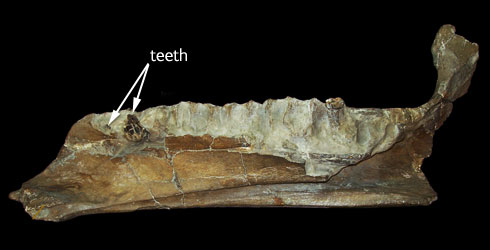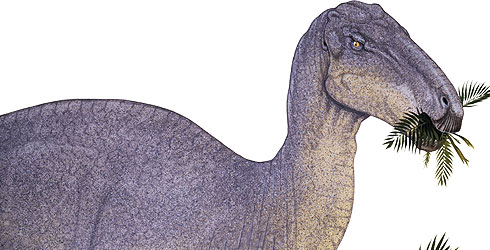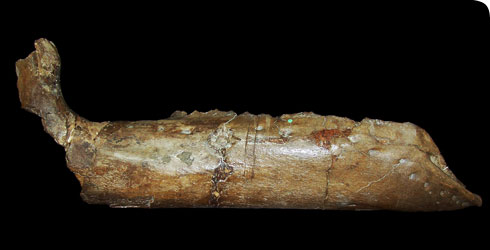Kukufeldia tilgatensis
This fossil specimen was discovered 160 years ago in West Sussex, England, and was commonly referred to as the ‘Brickenden jaw’. It resides here, in the Museum’s collections.
Dr Gideon Mantell identified the jaw as Iguanodon. However, a recent re-examination of the jaw by a visiting student, Andrew McDonald, revealed that the jaw differed from those of Iguanodon in several respects.
Following extensive work by a team of researchers at the Museum, the jaw was described as an example of a previously unidentified dinosaur, and was named Kukufeldia tilgatensis in 2010 - 160 years after the specimen was first discovered.
Species detail
It is difficult to estimate the size of Kukufeldia on the basis of a single jaw. However, if its general body proportions were similar to that of other Iguanodon-like dinosaurs, the length of the jaw suggests that the animal would have reached approximately 6–7 metres in length.
-

Taxonomy
For a long time this fossil jaw was thought to be from an Iguanodon. However, the specimen was recently re-examined and key differences between the dinosaurs were highlighted. Discover what sets Kukufeldia apart from its close relatives.
-

Distribution
The only known specimen of Kukufeldia was found near a village in West Sussex, England in rocks that are more than 130 million years old. Explore Kukufeldia’s ancient world.
-

History of discovery
The only specimen of Kukufeldia first came to light 160 years ago, but it was only properly identified in 2010. Follow the history of this unique fossil.
Images

Holotype specimen of Kukufeldia tilgatensis (NHMUK 28660), a right lower jaw in medial view, showing the preserved teeth.
© Modified from McDonald et al, 2010
Holotype specimen of Kukufeldia tilgatensis (NHMUK 28660), close up on the tip of the right lower jaw in lateral view. The various holes (‘foramina’) shared in common with other species of iguanodontian are shown in blue and yellow. The row of foramina that is unique to Kukufeldia, and which distinguishes it as a new species, is highlighted in red.
© Modified from McDonald et al, 2010
Iguanodon, a close relative of Kukufeldia. It is likely that Kukufeldia had very similar overall body proportions and an almost identical way of life.
© Natural History Museum, LondonAbout the author

Prof Paul Barrett
Dinosaur researcher and head of the Vertebrates and Anthropology Palaeobiology Division.
A word from the author
"For me, the discovery of this species highlights the central role that museum collections play in understanding biodiversity. It shows that looking at old specimens with new eyes can reveal large amounts of previously unappreciated information – in this case the recognition of a new dinosaur."
Toolbox
References
Mantell, GA (1848). On the structure of the jaws and teeth of the Iguanodon. Philosophical Transactions of the Royal Society of London 138, 183–202.
McDonald, AT, Barrett, PM and Chapman, SD (2010). A new basal iguanodont (Dinosauria: Ornithischia) from the Wealden (Lower Cretaceous) of England. Zootaxa 2569, 1–43.
Buy dinosaur books online

Visit the online shop to find all our dinosaur titles. Discover these amazing creatures with our range of dinosaur books for all ages.
You can also buy other books, DVDs and lots of gifts inspired by the natural world.
